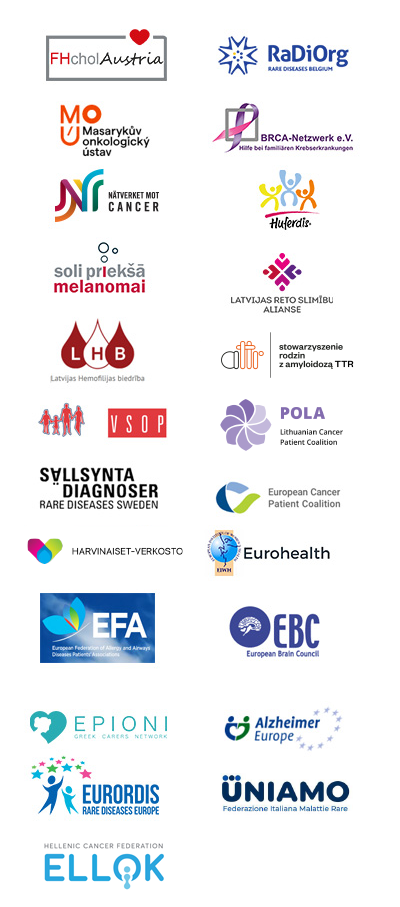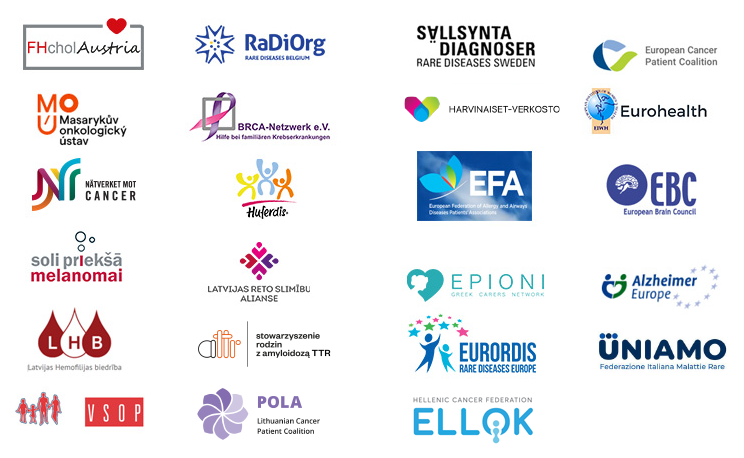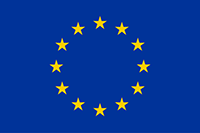I am looking for information as
Researcher

Industry

Patient

BBMRI-ERIC and the Stakeholder Forum Patient Pillar release co-written statement in support of EHDS opt-out meeting
This article is 1745 words and is an approximate ten minute read.
The following statement, co-written by BBMRI-ERIC and the Stakeholder Forum Patient Pillar, has been made in support of the EHDS opt-out meeting that happened on 6 September 2023. Details can be found here.
The purpose of this statement is to highlight the risks and opportunities of EHDS for biobanking from the viewpoint of patient advocates and patient representatives.
By utilising health data, such as information collected during routine patient care or stored in biobanks, for scientific purposes researchers can uncover valuable insights into disease patterns, treatment effectiveness, and population health trends. This data-driven approach enables the development of personalised medicine, identification of genetic markers, and discovery of novel therapies with increased treatment efficacy and reduced adverse effects. Moreover, the secure sharing, and analysis of health data across borders, particularly at European Reference Network (ERN) level, can foster collaboration among scientists, accelerate medical breakthroughs, and enhance public health strategies.
Embracing the secondary use of health data empowers researchers to make evidence-based decisions, shape healthcare policies, and ultimately improve the well-being of individuals and communities. In the biobanking field, health and clinical data associated with the samples and data stored in biobanks are crucial for advancing biomedical research and medical knowledge. The use of samples for research is much less valuable without the associated health and clinical data. Therefore, the new framework for the secondary use of data will greatly impact the biobanking field.
For BBMRI-ERIC, its National Nodes and the Stakeholder Forum Patient and Citizen Pillar, the European Health Data Space (EHDS) framework and the use of health data to drive innovation and promote scientific discoveries means a paradigm shift. This poses challenges and opportunities which are addressed in this statement.
The current proposal is highly welcome but still does not sufficiently consider the needs of and risks for patients/citizens, while calling for ‘data altruism’ in return. The upcoming EHDS is important because a single law and a standardised opt-out/consent regime in Europe aims to simplify procedures for investigators and patients/citizens alike. Differing jurisdictions in European countries delays research and creates uncertainty for citizens/patients. Nonetheless, the EHDS needs to be complementary to existing laws (e.g., the General Data Protection Regulation, GDPR or national biobank legislations), remain complementary to functional procedures and oversights that are established by the community and work well for biobanks.
Challenges concerning control over data
Whereas the sharing of data by patients/citizens is typically based on altruistic motives, demanding data altruism can risk categorising ‘good’ citizens (in favor of sharing data) and ‘bad’ citizens (not in favour of sharing data) and may stigmatise, rather than integrate, their motivations and concerns.
- There is a concern that the opt-out approach might not adequately inform patients about data sharing, potentially leading to a lack of understanding of the implications of sharing their data for research.
- Neither does the perfect consent model exist, nor does everybody want to use all options in dynamic/layered consent models. Every consent model has advantages and disadvantages. They must be mitigated if a choice for a specific model is made in a specific context.
- Whereas consent procedures will vary, nationally and locally, due to legal and cultural needs, for the purpose of the realisation of EHDS, the consent/opt-out regime should be standardised across the EU. Such a (standardised) consent/opt-out model needs to be carefully explored and requires transparent decision-making prior to its implementation. Access procedures must be defined in line with consent constraints. For example, it can be defined that investigators only get access to data they need, and data stays in the place it is obtained/stored (e.g., ‘analysis to the data’ models)
- An opt-out procedure can give citizens control over their data. This is the case when measures are taken to ensure that it will not lessen the person’s access to medical care, especially in emergencies, create discrimination or other barriers when accessing healthcare services. The way to reverse the initial decision and join back in should always be open. This option is especially relevant when the decision was made on behalf of a minor by the parents/legal guardians.
- Whereas the EHDS intends to facilitate research through the possibility to link data from different sources and thus foster research and drive innovation, the risks of identification and stigmatisation increase. These risks should be mitigated and new legislation may be neeeded. Citizens’ rights under the GDPR need to be guaranteed. The right to be forgotten, for instance, is essential and must be upheld when EHDS is realised.
- Biobanks contain biological materials and associated data often on the legal basis of consent or a specific biobank law. The EHDS needs to be set up in a manner that allows researchers to operate smoothly across research regimes.
Recommendations
- Rules and procedures for ‘secondary use of health data’ need to be implemented in the development, as well as operation, of EHDS to shape a ‘learning health system’ together with patients/citizens so that the advantages of research are showcased.
- Transparency is key. We therefore suggest a public registry of requests for access to health data could be established and maintained including information about the applicant, an ethical statement, the outcomes of the secondary use of health data and their use, etc. For example, consider the possibility of an alert system for each access request and consult citizens when building it – not all want to be alerted by default.
- Data needs to be stored in the primary process (care) in a harmonised, standardised, and regulated way, so that ‘secondary use’ (research) is possible, but it also becomes possible to promote ‘primary use’ of data for the immediate benefit of patients, and their care. If citizens are informed about this primary goal and are aware of the benefits, they may also be more willing to be altruistic and trust ‘secondary use’. This may help to create a trustworthy research environment. Different ways of data use are already in place and work well. In the case of biobanks, the data is typically pseudonymised and/or shared in secure processing environments (SPEs).
- Educating patients about EHDS, biobanking, and the potential benefits of data sharing for research and public health and improved awareness can help dispel misconceptions and build trust among patients.
- Implementing communication campaigns focused on the concept and advantages of the secondary use of health data could offer a more comprehensive understanding of the lifecycle of such data. These campaigns would emphasise the significance of utilising health data for research or public interest purposes.
- Participation by citizens in the oversight of EHDS on national as well as European level must be guaranteed. The involvement of patients and patient organisations should be a considered a fact in the EHDS. Patients must have a well-defined role in the oversight and decision bodies of EHDS (e.g., the data permit authority) and their participation be institutionalised as that of other stakeholders.
- Equitable access to research outcomes and innovations driven by EHDS and biobanking, particularly for marginalised and underrepresented groups, should be ensured.
- Patients and patient advocates must be recognised as two distinct groups. Patients, patient representatives, and patient advocates should be acknowledged as a diverse collective, representing varying opinions with specific interests or needs (e.g., rare disease patients, chronic diseases etc). This diversity must be taken into consideration. Patients with an ultra-rare disease, for instance, can be easily identified; special care is required when distributing their samples/data in order to preserve their privacy.
- To complement security measures, laws against misuse of data such as anti-discrimination laws, are urgently needed to not only protect data, but citizens in an effective manner.
- Interoperability and connectivity of the EHDS with biobanks, secure processing environments etc need to be ensured in a complementary, building block manner.
- For all these measures, constant dialogue with patients/citizens should be the guiding principle.
Statement ENDS.
A PDF of this statement is available for download.
Background
The European Health Data Space (EHDS) is an ambitious health data sharing framework establishing clear rules, common standards and practices, infrastructures, and a governance framework for the use of electronic health data across the EU. It differentiates between primary use (e.g., health care) and secondary use (e.g., health research).
In June 2023, BBMRI-ERIC joined together with 31 other health stakeholders to share views on specific recommendations for a potential opt-out mechanism in the future European Health Data Space. The June statement is available here (PDF).
Dr. Michaela Th. Mayrhofer, Head of ELSI Services and Research, said:
“We support the approach taken in the Commission’s original legislative proposal from May 2022 as it strikes a sensible balance between protection of personal data while enabling the use of data for research and innovation to create tangible benefits for patients and citizens. We see the proposal for an opt-out mechanism for citizens to withdraw their data from secondary use purposes as the better option for realising the European Health Data Space (EHDS).
At the same time, we call for a balance between the needs of research and patients/citizens, while remaining complementary to existing laws such as national biobank laws while updating anti-discrimination laws and such.”
As outlined in the June statement, the Commission’s EHDS proposal makes no provision for a consent mechanism for HealthData@EU (secondary use) beyond referring to national law (Art 33 (5)). This approach has been justified because (a) data for secondary use are either anonymised or pseudonymised and (b) there are strong mechanisms in place to safeguard against abuse, including lists of permitted uses (Art 34) and prohibited uses (Art. 35) and rules for governance and practical mechanisms.”
Today’s co-written statement puts forward recommendations for the realisation of the EHDS for biobanking from the viewpoint of patient advocates and patient representatives, especially its challenges and opportunities. The upcoming EHDS is important because a single law and a standardised opt-out/consent regime in Europe can simplify procedures for investigators and patients/citizens alike.
Differing jurisdictions in European countries delays research and creates uncertainty for citizens/patients. Nonetheless, the EHDS needs to be complementary to existing laws (e.g., the General Data Protection Regulation, GDPR or national biobank legislations), remain complementary to functional procedures and oversights that are established by the community and work well for biobanks.
More information:
- Read the June opt-out statement made with 31 other stakeholders
- Learn about this Stakeholder Forum Patient Pillar and listen to why it is so important for informing BBMRI’s strategy.
- Read about the work of the ELSI team.
- Contact BBMRI about this statement.






